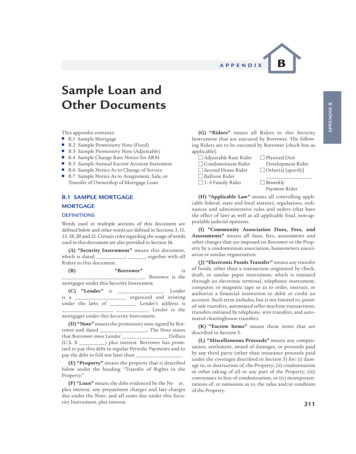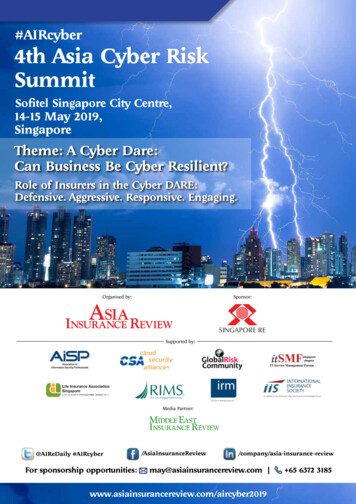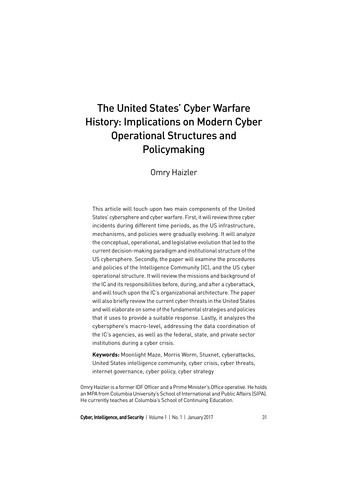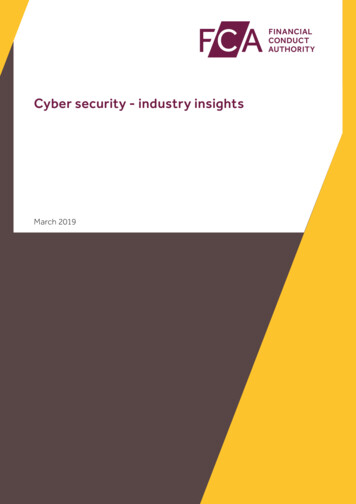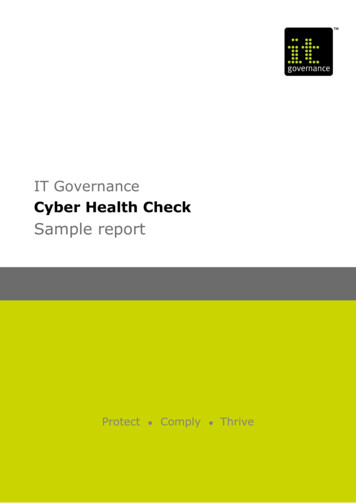
Transcription
IT GovernanceCyber Health CheckSample reportProtect Comply Thrive
Cyber Health Check Sample ReportClient: Baratheon PLCCyber Health CheckPrepared forEvelyn Murphy,Chief Information Officer,Baratheon PLCCHC Sample ReportCopyright IT Governance Ltd 2016Page 2 of 19
Cyber Health Check Sample ReportClient: Baratheon PLCTable of contents1.Introduction . 42.Executive summary . 53.Context . 74.Methodology . 85.Findings . 96.Conclusion . 16Appendix A: Staff cyber security compliance survey . 17Appendix B: Vulnerability scan . 18Appendix C: Anatomy of an advanced persistent threat (APT) attack . 19CHC Sample ReportCopyright IT Governance Ltd 2016Page 3 of 19
Cyber Health Check Sample Report1.Introduction1.1BackgroundClient: Baratheon PLCBaratheon PLC (Baratheon) invited IT Governance to perform a high-level Cyber HealthCheck in order to provide an independent, external assessment of its exposure to cyberrisk.The health check took place at the head offices in London on 13 January and included anonline staff questionnaire. This was supported by a remote systems assessment, whichtook place on 19 January.This Cyber Health Check is, by nature, high level and depends on information providedby senior personnel; it is not, and should not be treated as, a detailed audit of cyberexposure against a specific cyber control set.For information on the nature of a cyber threat that could be launched by a motivatedintruder, please see Appendix C.CHC Sample ReportCopyright IT Governance Ltd 2016Page 4 of 19
Cyber Health Check Sample Report2.Client: Baratheon PLCExecutive summaryFollowing IT Governance’s high-level review of Baratheon’s cyber health, we considerthat the company has all the building blocks in place for effective cyber security and –most importantly – management commitment to security.We have made 23 recommendations to improve cyber security. We have grouped ourrecommendations, below, under three headings: 2.1 Basic cyber hygiene; 2.2 Cybergovernance framework, and; 2.3 Policies, procedures and technical controls. Findingsfrom the Cyber Health Check are detailed in Section 5.2.1Basic cyber hygieneRecommendations are: 2.2Undertake regular independent penetration testing (recommendation 10);Enforce encryption policies for removable media (recommendation 21);Review event logs on a regular basis (recommendation 22).Consider the business need to extend secure email facilities (recommendation13);Consider using an email filtering system with enhanced facilities(recommendation 14);Ensure high-privilege user accounts are assigned to unique individuals (i.e.not shared) (recommendation 19);Consider implementing a security information and event management (SIEM)system (recommendation 23).Cyber governance frameworkIt is a basic cyber security principle that, without effective board-level cyber governanceand risk management, organisations remain vulnerable to cyber attack.Actions that should be taken are: 2.3Introduce metrics to provide stakeholders with assurance and visibility thatcyber security controls are operating effectively (recommendation 1);Improve information security skills (recommendation 6);Enhance and evaluate staff training and awareness (recommendations 7, 8and 9);Undertake a Cyber Essentials Plus assessment (recommendation 16).Develop an information asset register (recommendation 2);Establish a formal risk register and define risk appetite (recommendations 3and 4).Policies, procedures and technical controlsCyber attackers look for and exploit known vulnerabilities.Actions should include: Clearly communicating location of key policies to staff (recommendation 5);Ensure that any third-party patching requirements are adhered to(recommendation 11);Review the current web surfing policy (recommendation 12);Ensure all visitors are provided with visitor’s passes on entry to the building(recommendation 17);CHC Sample ReportCopyright IT Governance Ltd 2016Page 5 of 19
Cyber Health Check Sample Report Client: Baratheon PLCEstablish controls for zero-day malware attacks (recommendation 18);Investigate firewall intrusion detection facilities (recommendation 15);Introduce a formal bring your own device (BYOD) policy (recommendation20).CHC Sample ReportCopyright IT Governance Ltd 2016Page 6 of 19
Cyber Health Check Sample Report3.3.1.Client: Baratheon PLCContextBaratheon PLCBaratheon PLC (Baratheon) provides market research and analytics solutions to B2Cretailers of all sizes. Its proprietary analytics technologies are available to clients as amanaged online service or in slimmed-down versions as commercial off-the-shelf (COTS)software. The company also offers a number of street research and consultancy services.The organisation is global in scope, with offices in London, where it has its headquarters,and further offices in New York, Paris and Melbourne.There are approximately 400 members of staff at the London head offices, coveringfunctions such as IT, Sales, Marketing, Account Management and Development.3.2IT Governance LimitedIT Governance Ltd was identified as a company that has the experience to provideprofessional service to organisations, and ongoing support and advice in relation to theadoption and implementation of management systems and processes to manage cyberrisk and, as such, has been asked to perform the Cyber Health Check described withinthis report.CHC Sample ReportCopyright IT Governance Ltd 2016Page 7 of 19
Cyber Health Check Sample Report4.4.1.Client: Baratheon PLCMethodologyApproachThe Cyber Health Check consists of a four-phase approach.Phase 1: Identify cyber risk Identify key digital assets, including personally identifiable information(PII). Identify the major threats and cyber risks to those assets. Identify risk appetite on a scale between cautious and aggressive. Identify key legal, regulatory and contractual obligations, such as the GDPRand the PCI DSS.Phase 2: Audit planned mitigation Assess effectiveness and completeness of the controls in place to deal withthe identified risks, looking at people, process and technology. Review onsite wireless network security implementation. Conduct remote vulnerability scans of websites and internet connections. Deploy an online staff questionnaire to gauge employee understanding oftheir role in protecting the organisation.Phase 3: Analyse cyber risk Identify the areas in which controls are weak and fail to meet the riskmanagement and compliance objectives. Identify the most appropriate controls or control frameworks that will costeffectively close the gaps to an acceptable level.Phase 4: Prioritise improvements Develop a prioritised action list with a roadmap of recommendations. Identify what must/can be done immediately to address the most criticalrisks.CHC Sample ReportCopyright IT Governance Ltd 2016Page 8 of 19
Cyber Health Check Sample Report5.5.1.Client: Baratheon PLCFindingsGovernance and cyber security framework5.1.1 Initial overviewBaratheon considers itself to be primarily at risk of cyber attack through the receipt ofemails that contain malicious software or purport to be from a legitimate source.Baratheon has suffered from spoof emails encouraging staff to make payments thatexceed their authority.Management has raised additional concerns regarding the potential for a motivatedintruder to remove data, and physical security issues. Aside from the motivated intruder,Baratheon considers itself to be subject to opportunist attack rather than from a targetedattack.As Baratheon devices are frequently connected to client environments, those devicesmust be free of malware to avoid the risk of infecting client systems, and to avoiddamage to Baratheon’s reputation.5.1.2. Cyber risk governanceCyber risk governance is discussed and managed by the directors at board meetings ona regular basis. Evelyn Murphy (CIO) is responsible for and has ownership of mattersrelated specifically to information security, in coordination with Ivan Kosminski (COO),who has ownership of quality- and security-related matters.Recommendation 1: We consider the next step in the cyber governance process is toestablish metrics to give the board assurance that key elements of cyber security are inplace and operating, covering:a) Basic technology cyber hygiene indicators on:oooothe security of boundary firewalls and internet gateways;establishment of secure configurations;access control arrangements;patch management, which includes vulnerability scans of the internalnetwork.b) Adherence to a staff training and awareness programme, and the results ofsurveys and audits of staff understanding.5.2.Cyber management5.2.1. Asset registerBaratheon is in the process of amalgamating and formalising its existing asset registersinto one manageable database, which will become the organisation’s asset register.Information does not form part of the existing asset registers. Baratheon’s data is hostedon virtual servers with a document management system shared by all divisions, which isa key asset for the business. Baratheon will need to establish an information inventoryand identify owners for that information as a basis for ensuring that any Baratheon dataheld by third parties is protected by appropriate security. We also note that there is noformal classification scheme in place for information assets.Recommendation 2: Baratheon should develop an information asset register andreview its proposed classification scheme.CHC Sample ReportCopyright IT Governance Ltd 2016Page 9 of 19
Cyber Health Check Sample ReportClient: Baratheon PLC5.2.2. Risk registerA number of outstanding actions from security reviews are being tracked by Baratheon,but there is no formal risk register. Baratheon also has no defined risk acceptancecriteria.Recommendation 3: A formal risk register should be established. The risk registerserves as a central repository for the organisation's risk information and allowsinformation resulting from the risk management process to be suitably sorted andstandardised. Its key function is to provide management, the board and keystakeholders with significant information on the main risks faced by the organisation.The risk register also gives the organisation's risk management stakeholders a clear viewof the current status of each risk at any point in time. The risk register should be ownedby an executive member of the board.Recommendation 4: A suitable risk appetite should be defined so that the amount andtype of risk that Baratheon is willing to take in order to meet its strategic objectives andsupport sustainability is recorded, and this can then be used to perform an accurate riskassessment.5.2.3. Legal, regulatory and contractual requirementsBaratheon demonstrated an in-depth knowledge of its current legal, regulatory andcontractual requirements, such as those relating to the Data Protection Act, anti-bribery,freedom of information, computer misuse, licensing regulations, Marketing ResearchSociety requirements, UK employment law and UK health and safety.There have been no reported breaches of legal, regulatory and contractual requirementsin the last 12 – 24 months.5.2.4. Policies and ISMSBaratheon has put in place a high-level information security policy, a range of acceptableuse policies and an incident response reporting procedure. These have been madeavailable to staff on the company intranet.The staff survey (see Appendix A) posed questions on the awareness of policies.89% of respondents are aware that Baratheon has policies but, worryingly, 11% of staffclaim to be unaware of policies, and 59% do not know where to find policy information.Of most concern is that 36% of staff claim not to know of the incident reportingprocedure, and 49% would not know how to report an information security incident or towhom.As cyber incidents can be identified in real-time or after the event, speedy awareness ofincidents is essential to be able to minimise the impact and to take remedial action.Recommendation 5: As a matter of urgency, Baratheon should communicate thelocation of policies to staff and highlight the importance of the incident reportingprocedure. Awareness of other policies should be subsequently communicated.5.2.5. Roles and responsibilitiesThe CIO is accountable for the security of the IT systems and the data held therein. TheIT Manager is responsible for IT support and security. There are no formal cyber securityqualifications held by anyone within the organisation.CHC Sample ReportCopyright IT Governance Ltd 2016Page 10 of 19
Cyber Health Check Sample ReportClient: Baratheon PLCOur vulnerability assessments have highlighted critical vulnerabilities in theinfrastructure, and we have suggested a number of areas where security couldpotentially be improved – such as data loss prevention (that is, identifying emailcontaining sensitive data leaving the organisation) and implementation of a securityinformation and event management system (SIEM).Mitigating cyber risk requires personnel who are able to understand cyber attack vectors,assess the threat horizon, and identify and implement appropriate technical andprocedural counter measures, and we note that Baratheon does not have staff withprofessional security qualifications, such as Certified Information Systems SecurityProfessional (CISSP)1, Certified Information Security Manager (CISM)2 or InformationSystem Audit and Control Association (ISACA) cyber security qualifications3.The acquisition of recognised qualifications by staff responsible for security wouldprovide a stronger governance position, and assurance to the board that the IT functionhas the capability to identify and, as a result, mitigate the widest set of cyber threats.Recommendation 6: Baratheon should review cyber security skills and competences,and ensure its IT staff have adequate cyber security skills to help meet current cyber riskchallenges.5.2.6. Staff training and awarenessBaratheon staff receive a brief IT training session run by the IT Manager as part of theirinduction, which provides limited coverage on information security.There is no formal process in place for raising information security awareness, and it islikely that Baratheon may not be able to rely on staff capabilities to resist cyber attacks.The board has previously been informed of phishing attacks that are targeted atsenior/director-level staff (whaling). Staff are the primary route for the introduction ofmalware into systems and data loss through poor information handling. Therefore, stafftraining is a key management control.The staff survey indicates that all but two individuals would refuse to discloseauthentication details to their bank. Given the publicity surrounding criminals attemptingto gain access to bank details, it is surprising that two individuals are still susceptible tothis social engineering attack. Baratheon staff are clearly very trusting, as 70% wouldhand over their login details to a senior member of staff over the phone, 34% would notcheck an email from a customer, 54% do not lock their screen when leaving their desk,over 94% hold doors open for others, and over 54% do not ever challenge strangers inthe workplace. This user behaviour indicates that staff are susceptible to socialengineering attacks and phishing attacks.Management acknowledges that staff training could be improved through updating thematerial and provision of more regular training activity. Industry best practice is toconduct staff refresher training at least annually, and to include tests of comprehensionof the training material.Recommendation 7: Baratheon should establish an annual training programme forstaff. Given the spread of locations and the limited resource to conduct training, weCISSP is offered by (ISC)2.CISM is offered by ISACA.3ISACA offers cyber security qualifications at Fundamentals, Practitioner and Specialistlevels.12CHC Sample ReportCopyright IT Governance Ltd 2016Page 11 of 19
Cyber Health Check Sample ReportClient: Baratheon PLCsuggest investigating e-learning to ensure that current and consistent messages aredelivered to staff. We also recommend that completion of annual staff training is a keymetric.Recommendation 8: In addition to training, a formal information security awarenessprogramme with quarterly updates on key topics should be introduced.Recommendation 9: Staff training is a key control to minimise the risk of cybersecurity incidents and, despite comprehension tests, the ability of staff to use thatinformation to work securely is a further aspect to consider. Therefore, we recommendthat Baratheon considers conducting social engineering and phishing exercises todetermine staff awareness levels and understanding.5.3.Cyber security controls5.3.1. Secure configurationThere are baseline builds for laptops and desktops, using a mixture of Windows 7 and 10operating systems, and some internal applications are built on Vista systems. All serversare Windows 2012.Microsoft Active Directory is used to manage group policy and passwords. ActiveDirectory is also used to configure servers, routers and firewalls. There is a defaultsecurity policy for all machines. There are group policies and standard user policies suchas for standard users and the Network Team.File server permissions are controlled by Active Directory according to group.Network access points are totally locked down.Active Directory is used as a network and application device inventory, and new devicesare added manually.There are no exceptions in the standard build across the organisation, which includesMicrosoft operating systems and the Office package.iPhones are used throughout the organisation and these synchronise by ActiveSync toMicrosoft Exchange.All Windows machines are patched in line with the Windows patching policy on a monthlybasis. Baratheon has a group set up that includes a laptop, desktop and server, which ispatched before the latest patches are rolled out across the organisation.Antivirus updates are rolled out using the central console, which is also used to governgroup policy. Antivirus updates are set to update automatically throughout the estate.The organisation’s website is patched at the same frequency and time as other machineson the estate.Notifications for updates to firmware for the firewalls are sent to the Network SecurityTeam before being tested and applied.Recommendation 10: Penetration testing should be carried out on an annual basis toassist in preventing cyber attacks.Recommendation 11: Baratheon should understand any third-party patchingrequirements and ensure that they are adhered to.CHC Sample ReportCopyright IT Governance Ltd 2016Page 12 of 19
Cyber Health Check Sample ReportClient: Baratheon PLC5.3.2. Perimeter controlsThere is a multi-layered network defence perimeter in place, which consists of a DMZ forthe web servers and network firewalls. A small team of network engineers manage thenetwork. There is some segregation with the web servers in the DMZ and there are testservers but there is no test network.Automated scanning is set up on wireless access points.Currently, there are no restrictions on web surfing, but Baratheon is in the process ofinstalling a proxy server with a view to providing this capability.There is a wide range of web browsers installed in line with the needs of the business,but these cannot be controlled in any way using group policy and, again, restrictions arelimited.Restrictions on the size of email attachments that can be sent are in place: 20 MBexternally and 5 MB internally.Transport Layer Security (TLS) is used as email encryption on some clients’ accounts butthis is not used across the board.Baratheon’s UK operations are based on a single site near Regent’s Park in London, withthe company occupying several floors of a serviced office block. Physical access to thebuilding is well handled with an automated reception log in system. All visitors areaccompanied into the office areas, but visitors do not receive badges so staff may notrecognise whether someone is supposed to be in the office space or not.Recommendation 12: Web surfing policy should be reviewed and designed to fit boththe needs of the business and risks to the organisation’s cyber security.Recommendation 13: Baratheon should review availability of encrypted email facilities;if the risk-reward ratio is appropriate, make the facility more widely available.Recommendation 14: Baratheon should consider using a fully-fledged mail filteringsolution to gain better control of the spam and make use of other features such as dataloss prevention (which can identify and trap confidential data being emailed out of theorganisation).Recommendation 15: Investigate intrusion detection systems options on the firewall,which will provide monitoring of malicious activity.Recommendation 16: Baratheon should undertake a Cyber Essentials assessment.4Recommendation 17: All visitors should be provided with visitor’s passes on entry tothe building.5.3.3. MalwareAntivirus software protects the Windows firewalls and also scans the Microsoft ExchangeServer. The antivirus is deployed across 100% of the estate. The antivirus is set to autoupdate and pushes out the signature updates as and when they are received. Internaland on-access scanning are enabled and carried out automatically.Cyber Essentials scheme sentials-scheme-overview.4CHC Sample ReportCopyright IT Governance Ltd 2016Page 13 of 19
Cyber Health Check Sample ReportClient: Baratheon PLCIf laptops are not connected to the network, the antivirus is set up to automaticallydownload signature updates when an Internet connection becomes available.Suspicious email attachments are quarantined or removed by the antivirus and alerts aresent to the user and the IT Team if any suspicious attachments are detected.The antivirus is not configured to block emails with links.Blacklists block spam at the firewall before it arrives at the Exchange server.There are no specific controls in place for zero-day malware attacks.Recommendation 18: Zero-day malware attacks should be added to the risk register.Once this has been established, a full risk assessment should be carried out to ascertainthe risk of this type of malware attack to the organisation.5.3.4. User access and user privilegesMicrosoft Active Directory is used to control user access and privileges.Access to systems and applications is provided according to a role-based system.Default passwords for systems and applications ae changed via Active Directory.Password complexity is set to eight upper- and lower-case characters with one number.Passwords expire after 30 days.New users are created when a New User form is completed and provided to the IT Team.New users are forced to create a new password on first login. New users are trained bythe IT Team on the password policy on induction.All PCs and laptops are encrypted. Encryption on desktops is synchronised with theActive Directory or network password. Laptops have two passwords: the encryptionpassword and a network password.A Leaver’s form is provided to IT when a user leaves the organisation. The user is eithersuspended or disabled in Active Directory and this removes access across the estate.The IT Team has two accounts: a standard network account with low-level privileges,and a privileged account with higher-level administrator privileges the authenticationdetails for which are shared between a handful of team members.The Wi-Fi is connected to the firewall, hidden logically and filtered by MAC address. Wi-Fiis segregated and has its own port on the firewall so additional rules can be set up.Recommendation 19: Ensure that all admins use a separate account as namedindividuals, and extend this approach to all systems where possible.5.3.5. Mobile devices, mobile working and removable mediaBaratheon makes use of a number of mobile devices, which are used by a largely mobileworkforce. Various data can be accessed using the devices, including email, documentsand photos, and they can backup data to Cloud-based accounts.There is no formal bring your own device (BYOD) policy. Furthermore, a lack of mobiledevice management means that technical controls are also not in place to help governthe use of mobile devices.As yet, there are no physical restrictions preventing access to network devices byremovable media. We recommend that builds are hardened using tools such as SecurityCompliance Manager.CHC Sample ReportCopyright IT Governance Ltd 2016Page 14 of 19
Cyber Health Check Sample ReportClient: Baratheon PLCA recent incident involving customer data being left on a desk in an unencrypted USBdevice was identified. The USB stick was left by an employee who had copied some dataand then left it on the desk. Eventually it was picked up and checked, and found to havesensitive information on it. This highlights the need to enforce encryption policies andgain better control over removable devices and information. If the device had been leftsomewhere public, then the damage could have been significant.Recommendation 20: Baratheon should formalise the BYOD policy to give staff clearguidance on the issue. Users should acknowledge the policy on a regular basis. We alsorecommend implementing mobile device management to gain better control over mobiledevices.Recommendation 21: Baratheon should introduce and enforce encryption policies forremovable media.5.3.6. Security monitoringThere is a monitoring strategy in place and improvements are being made as and whenpossible in line with the needs of the business.Monitoring is not carried out in real time but alerts are set up to notify the IT Team ifany exceptions occur. Monitoring is set up across the estate on servers, workstations,laptops, firewalls, etc.Improvements could be made to storage of the firewall logs, as currently they are kepton the firewalls themselves and capacity is limited so logs are overwritten. If the logswere offloaded to an internal server, then they could then be archived for access at alater date.Microsoft Exchange logs are monitored and stored.Recommendation 22: We recommend Baratheon reviews the available event logs inthe infrastructure on an ongoing basis, and ensures that at least three months' logs areavailable to support incident analysis.Recommendation 23: Baratheon should consider implementing a security informationand event management system (SIEM) that centrally logs key events and security typeevents from servers, network devices and other consoles. This will allow simpleevaluation of risks and identification of breaches.5.4.Business continuity and incident managementBaratheon has a disaster recovery plan, but no formal business continuity managementsystem in place. Although its disaster recovery plan does not directly link to IT incidents,all incident calls are reported to IT. Cyber incidents will be handled by the IT departmentin the first instance, and then raised with the CIO and, if appropriate, the Board.As Baratheon has a small, dedicated IT team and the CIO is very close to operationalactivity, we are satisfied that incidents will be escalated appropriately. However, as notedin the staff survey, there is a real concern of an incident being reported in a timelymanner.CHC Sample ReportCopyright IT Governance Ltd 2016Page 15 of 19
Cyber Health Check Sample ReportClient: Baratheon PLC6. ConclusionManagement awareness of cyber risk is high but Baratheon needs to take a numberof steps to improve its cyber health.There are a number of security policies that need to be created and/or reviewed aspart of establishing sound information security practices. At the time of audit, thiswas a work in progress.Staff training and awareness was also a pressing concern, and we have maderecommendations to provide a more robust training and awareness programme forstaff.CHC Sample ReportCopyright IT Governance Ltd 2016Page 16 of 19
Cyber Health Check Sample ReportClient: Baratheon PLCAppendix A: Staff cyber security compliance surveyOut of approximately 400 staff, 100 responded to the invitation to complete an onlinequestionnaire.QuestionYesNoTo your knowledge, does Baratheon have IT policies?To your knowledge, does Baratheon have network, email andacceptable use policies?To your knowledge, does Baratheon have an incident reportingprocedure?To your knowledge, does Baratheon have DPA and privacy policies?To your knowledge, does Baratheon have social media policies?Do you know how to access company information and policies?Do you visit social media sites at work?If you received an email from your bank asking for authenticationinformation, would you supply it?If the CEO phoned you to ask for your username and password toassist in dealing with a malware intrusion, would you supply it?If you received a customer email with a link or attachment, wouldyou open it before first checking that it was genuine?Do you know how to identify if someone is attempting a socialmedia hack?Do you ever check that the person responding to you on socialmedia sites is who you think they are?Do you ever fill in quizzes and questionnaires on social media sites?If you suspected that you had witnessed an information securitybreach, do you know how to report it and who to?Do
cyber security controls are operating effectively (recommendation 1); Improve information security skills (recommendation 6); Enhance and evaluate staff training and awareness (recommendations 7, 8 and 9); Undertake a Cyber Essentials Plus assessment (recommendation 16). Develop an information asset register (recommendation 2);






